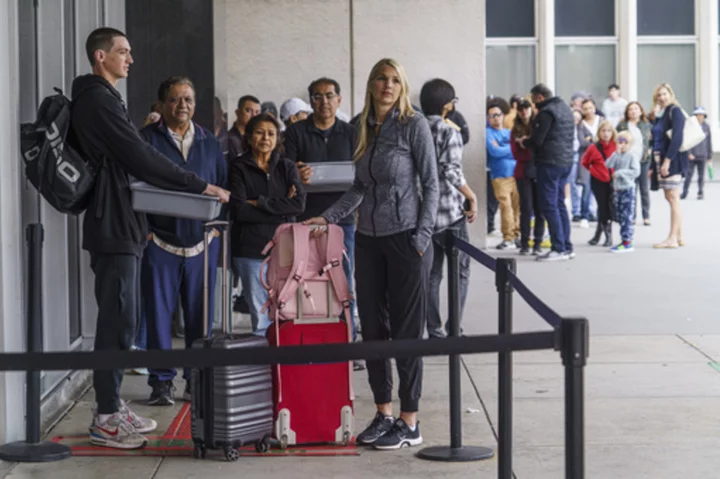
Drag queens are out, proud and loud in a string of coal towns, from a bingo hall to blue-collar bars
In red communities across America, lawmakers are pushing to restrict drag performances or LGBTQ+ rights
2023-07-04 00:19

Turkey country profile
Provides an overview of Turkey, including key dates and facts about this transcontinental country.
2023-07-03 21:51

European Stocks Muted After First-Half Gains; Energy Shares Rise
European stocks were muted on Monday following gains in the first half of the year as cyclical sectors
2023-07-03 21:20

Nutritionist explains how women can eat to help balance hormones
Some healthy eating principles apply to just about everyone – drinking enough water and consuming plenty of fresh fruit and veg, for example. But when it comes to hormones, a lot of diet advice neglects to mention the vast difference between women’s and men’s health. “Women are very under-represented in research, mainly because we have a menstrual cycle,” says functional nutritionist and author Pauline Cox. “My passion and mission is to empower women with the information and knowledge that can radically change their immediate health and their long-term health.” Cox, 43, who started her career as a physiotherapist before becoming a nutritionist, now mainly works with groups of women online and has just released her second book, Hungry Woman: Eating for Good Health, Happiness and Hormones. “I felt there was a lot of information that could be shared with women to help them understand their hormones, and understand that we don’t have to get frustrated with ourselves and fight our female physiology.” At the heart of the issue is the balance (or lack thereof) between oestrogen and progesterone levels. “When our progesterone levels are low, our oestrogen can become dominant, and that’s when we start to see things like PMS, heavy periods, painful periods, flooding at the beginning of our periods,” says Cox, who lives in Somerset. “A lot o women accept that as part of their monthly cycle, but when we bring our progesterone levels back up, it helps to balance the effect of oestrogen.” Here, she explains five ways women can tailor their diets to keep their hormones in check… 1. Look after your liver “Oestrogen is a driving-growth hormone,” Cox explains, using the analogy of grass growing on a lawn to explain how the two hormones interact. “Progesterone is like the lawnmower. It comes along and it keeps the grass in check. When we lose progesterone, oestrogen gets out of control.” That’s why it’s important that our bodies are able to clear oestrogen efficiently through the liver, gut and bowels. “How much oestrogen we clear can be influenced by what we eat and how we live,” says Cox. “There’s a lot of cruciferous in the book – cauliflower, broccoli, these are really great vegetables to support liver detoxification.” 2. Add fermented foods To deliver beneficial bacteria to your gut, try including fermented foods like pickled vegetables, kefir, kombucha or natural yoghurt as part of your daily diet. “Our gut diversity declines as we age and microbiome diversity has been linked with longevity and good health,” says Cox, who suggests just a tablespoon of sauerkraut a day can make a difference. “These are easy wins… to maximise our longevity and optimise our gut-brain axis, which is incredibly important.” 3. Avoid ultra-processed foods There’s been a lot of talk recently about how detrimental ultra-processed foods are, and that includes the effect on hormone levels. “When we’re eating high sugar, processed foods, our inflammatory levels go up and our cortisol level goes up, which robs us of progesterone,” Cox says. Plus, filling up with these empty calories – as delicious as they often are – means we have less room for nutritious foods. “They can often be devoid of nutrients, so you’re not getting the nutrients you need for building hormones and supporting hormonal health like magnesium, zinc, B vitamins, and omega three fatty acids.” 4. Create an eating window It’s not just what you eat, it’s when. Cox recommends having an ‘eating window’ during the day that ends around 6pm, so that there’s a gap of a few hours before you go to bed. “When your blood sugars go up at night, your kidneys have to kick in to try and remove this excess blood sugar, which then means you’re up in the night urinating,” she says. “A lot of women associate this with drinking a lot before bed, but actually eating late at night can also be for that reason.” Choosing meals that are nutritious and satisfying is the next step. “Within that window, start becoming a bit more conscious of your carbs and upping your protein,” she continues. “So you’re feeling full, your body’s getting all the amino acids it needs, and you’re maybe not having so much of the grab-and-go food like the sandwiches, the pasta, the crisps.” 5. Monitor your magnesium “Most women are sub-clinically deficient in magnesium,” Cox explains, which can cause insomnia, and the risk increases with age. “As we get to about the age of 40, we absorb less magnesium than we would have in our 20s.” Diet also plays a role: “If we have high blood sugars and levels of inflammation when we’re stressed, we lose magnesium.” She recommends taking a magnesium glycinate or bisglycinate supplement before bed to increase your chance of getting a good night’s sleep. “The glycine part of that helps to reduce your core body temperature, which is what the body wants when it’s going to bed,” she says. “That compound also helps get you into what’s called REM sleep, which is the sleep where you’re consolidating memories and learning.” ‘Hungry Woman’ by Pauline Cox (Ebury Press, £27). Read More From hairdressers to aloe vera: What will Diet Coke join as a ‘possible cancer risk’ Three quick and easy vegan fakeaway recipes The only three recipes you need to seize the summer How to shop at Borough Market in the summer
2023-07-03 21:19

Why Do Cats Lick Tape and Plastic?
Your cat's weird snacking habits may be related to compulsive behavior condition—or they might just like the crinkly sound.
2023-07-03 21:17

Algeria country profile
Provides an overview of Algeria, including key dates and facts about this north African country.
2023-07-03 19:16

The wait for US passports is creating travel purgatory and snarling summer plans
A much-feared backup of U.S. passport applications has snarled summer plans for would-be travelers around the world
2023-07-03 13:23

United May Cut Newark Flights as It Seeks More Gates to Stem Delays
United Airlines Holdings Inc. will have to change, and possibly reduce, its flight schedule at Newark Liberty International
2023-07-02 23:28

What to know about Fourth of July holiday origins and traditions
The Fourth of July is Americana at its core: parades and cookouts and cold beer and, of course, fireworks
2023-07-02 13:54

After several turbulent days, flight disruptions ease despite worries about 5G signals
Airline passengers who have endured tens of thousands of weather-related flight delays this week got a welcome respite from the headaches Saturday, despite concerns about possible disruptions being caused by new wireless 5G systems rolling out near major airports
2023-07-02 05:21

Louis Tomlinson’s sister, 19, reflects on ‘cruel’ backlash to being a ‘young mama’
Louis Tomlinson’s 19-year-old sister has reflected on the negative comments and criticism she received after announcing her pregnancy earlier this month. On 19 June, Phoebe Tomlinson revealed that she and her boyfriend, footballer Jack Varley, 26, are expecting their first child together. The couple said their firstborn is a boy, sharing the news in a gender reveal video posted on Instagram 10 days later. In the video, Varley pops a black balloon filled with blue confetti, before hugging Phoebe as they celebrate the news with friends and family. The model and mum-to-be later answered fan questions about her pregnancy journey on her Instagram stories, including whether she had dealt with any backlash for being a “young mama”. Phoebe replied: “Any nasty comments will get removed and blocked, so I just try and let them go over my head. That’s the downside of social media. And I’ve truly learnt in the past few weeks how incredibly cruel people can be. “I’m lucky I have an amazing family,” she added. Her twin sister Daisy left lots of blue heart emojis on Phoebe and Varley’s gender reveal video, while their older sister Lottie Tomlinson, 24, said she “can’t wait to meet” her nephew. Phoebe also responded to a 19-year-old fan who also “wanted a baby early in life but people were against it”. She said: “Why do ‘people’ matter? It’s your life, sweets.” Phoebe also shared she “feels like any other expecting mum” when asked if it was scary to become a mother at “such a young age”. Elsewhere, she said her brother Louis was “excited” to find out Phoebe and Varley were having a boy. While the former One Direction star wasn’t at the gender reveal, Phoebe told a fan she texted him a few days prior to the announcement. She also expressed her excitement at her baby meeting Daisy, and told a fan she becomes “emotional” when she thinks about Varley becoming a father. “I can’t wait to see them snuggle and to watch him thrive as a dad,” she added. Finally, Phoebe said that she felt her late mother Johannah Deakin “guiding us through” the pregnancy. Deakin died from leukemia in December 2016, aged 43. The family was dealt another tragic blow in March 2019, when the siblings lost their sister Félicité Tomlinson after she died from an accidental drug overdose, aged 18. Read More Kevin Costner’s estranged wife says she’ll move out of their $145m home on one condition Colleen Ballinger: Everything we know about the ‘grooming’ allegations against YouTuber Miranda Sings Sarah Jessica Parker reveals she and husband Matthew Broderick haven’t ‘spent a night apart’ in 31 years Ellie Simmonds decided to find her birth mother as she starts ‘new chapter’ with partner Matt Dean Nutritionist explains how women can eat to help balance hormones
2023-07-01 17:20

These high street iced coffees contain more sugar than Coca-Cola, Which? says
Some iced coffee drinks from high street chains can contain more sugar than a can of Coca-Cola, which contains 35g of sugar, a survey has found. Which? compared frappes and frappucinos from Caffe Nero, Costa and Starbucks to find many had “exceptionally high” amounts of sugar. A Starbucks caramel frappuccino with semi-skimmed milk was found to be one of the worst offenders, containing 48.5g of sugar – or 12 teaspoons’ worth. NHS health advice suggests adults consume a maximum of 30g of sugar per day, or around seven teaspoons. A Caffe Nero Belgian chocolate and hazelnut frappe creme contained 44.5g of sugar – equivalent to 11 teaspoons. At Costa, a chocolate fudge brownie frappe mocha with oat milk included 42.6g of sugar, or 10.5 teaspoons. Which? compared the amount of sugar in these drinks to a 51g Mars bar, which contains 31g of sugar (7.5 teaspoons), while a 330ml can of Coca-Cola contains 35g of sugar (around 8.5 teaspoons). Even plain coffee flavour frappes and frappuccinos were found to contain “relatively high” amounts of sugar. A Costa Coffee frappe with skimmed milk contained 21.3g of sugar, Which? found. While the calorie content of the drinks must be displayed in stores, the sugar content does not, which could leave consumers at risk of unwittingly exceeding the maximum recommended daily intake of free sugars, the watchdog said. Dairy-based drinks derive some “locked in” sugar from lactose, but all the drinks also contained high amounts of “free sugars”, which refers to sugars that have been added and contained in syrups, honey and fruit juice. Health advice is to limit consumption of these sugars due to their potential to contribute to weight gain and tooth damage. Which? suggested consumers wishing to cut their sugar intake switch to iced versions of a standard coffee instead. The government introduced a Soft Drinks Industry Levy (SDIL) in 2018, known as the “sugar tax”, in an attempt to cut unhealthy levels of consumption. However, some drinks are exempt from the tax, including fruit juices and drinks made on-site and served in open cups. Syrups, often used in frappes, are also exempt. Which? nutritionist Shefalee Loth said: “Our analysis of sugar content in iced coffee blends shows people could unwittingly be consuming much more sugar than they realise, with potentially damaging implications for their health. “High street chains need to take more responsibility and reduce the excessive sugar content of some of their drinks to protect people’s health. “When buying an iced drink, there are alternative, healthier options to choose, such as a standard iced coffee, which contains far less sugar.” A Starbucks spokesperson said: “We are committed to helping customers make informed and improved choices that work for them, offering a range of customisation options such as choosing our smallest size (Tall) and our oat dairy alternative with no added sugar. “Sugar content for an Iced Latte with Semi Skimmed Milk, one of our most popular beverages, starts from 8.7g for a Tall size. Customers can find all nutritional information available on our mobile app, online and our menu boards.” Caffe Nero described its Belgian chocolate and hazelnut frappe creme as a “treat” and said it accounted for less than 5 per cent of its sales of summer drinks, while “coffee over ice” drinks, which contained less than 8g of sugar, accounted for 50 per cent of summer drink sales. The chain added that its iced latte – its highest seller – contained no added sugar. Reporting by PA Read More Olivia Colman’s fight to end domestic abuse: ‘Women are still expendable’ Colleen Ballinger: Everything we know about the ‘grooming’ allegations against YouTuber Miranda Sings Kevin Costner’s estranged wife says she’ll move out of their $145m home on one condition Starbucks barista documents coffee chain’s alleged food waste in viral video Being lonely ‘may increase risk of heart disease in diabetes patients’ Sarcoma Awareness Month: What you need to know about these cancers
2023-07-01 13:15
